20 years of the evolution of the Internet in Ukraine, and which network do you remember 20 or 10 years ago?
By writing this publication I was encouraged by the publication on Habré of a rather lengthy article: “Nostalgia post. Secrets of Internet prices: why megabits can cost from $ 0 to $ 200 or how to get 100 Gbit / s for a penny? ” , Which, alas, turned out to be too overloaded due to the volume of the material in question and would be completely incomplete without this section. Especially since I come from Ukraine, I remember and know the topic from my own experience, so I would like to dwell separately on the history of the development of the Internet in our region and share memorable moments.

Moreover, this year marks 20 years since Ukrtelecom received the first foreign channel of huge capacity at that time in Ukraine - 2 Mbit / s to London. Yes, yes, 2 Mbit / s in 1997 to the whole country! And how do you remember the Internet? In the comments to this publication I propose to share your experience, when you first came online and how it was. It is necessary for the formation of a general picture of how much the transfer of data has decreased and what unique opportunities we have with you today in comparison with the era of the emergence of Internet providers. Let's start!
Back in 1988, the first experiments with data transmission on the territory of modern Ukraine were started by Ukrainian scientists, but the first providers appeared only in 1990. At that time, the electronic messaging service was widely spread in the world, and in the USSR one of the leading operators providing this service was "Relcom". In Ukraine, regional centers of access to this network were established at telephone and telegraph stations. Very soon, these sites came under the management of the newly established company “Relcom-Ukraine”, and therefore the Internet of that time was called by many “Relcom”.
Since 1991, a new joint venture, Infocom, was formed, which began building a national scale network based on long-distance analog channels of the Ministry of Communications of Ukraine, and the network has access to international data networks. A little later, thanks to the initiative of enthusiasts, the Internet zone .UA was obtained in 1992, and the Kharkov company Konkom, providing dial-up access between Kharkov and Moscow, acquired a dedicated line in this direction and was the first in Ukraine to switch to the Internet protocol TCP-IP , thus first implementing uninterrupted online access to the Internet network.
In 1994, there were already a few dozen Internet service providers in Ukraine, but the scale of Internet penetration was insignificant until 1999, when the number of subscribers in Kiev reached 10,000, access to the network for which was provided by about 50 providers. All this did not allow them in Ukraine to significantly modernize and expand their networks. However, nevertheless, in the initial period, this activity was not regulated by the state in any way, which allowed for healthy competition, in the absence of expensive licensing, which, however, they tried to introduce repeatedly, but most of the providers continued to operate without a license and the attempts of the authorities were unsuccessful.
At the end of 1994, Infocom invests about $ 3 million to build a national scale network, unites Kiev, Dnepropetrovsk, Lviv and Odessa, while providing Internet access for only 1000+ clients. A little later, Golden Telecom and Farlep are also actively building their own backbone networks between the major cities of Ukraine, which has a significant impact on the cost of their services, which only large companies could afford.
Home users appear the first local area networks in 1994-1996, mainly for the purpose of gaming and file sharing, initially uniting several computers within an apartment building that do not have access to the Internet. After a decade, the most active of them will turn into major Internet service providers providing access for hundreds, thousands and tens of thousands of subscribers at space speeds for the 90s - tens of megabits per second.
It is worth noting that www originates in 1991, along with html and http, however, the first Mosaic browser appeared only in 1993, and www gained popularity perhaps only from 1996, before that the Internet was used mainly for file transfer and e-mail.
The first international fiber-optic communication line (FOCL) was built in 1996 as part of the international project ITUR, it passed through Palermo (Italy), Istanbul (Turkey), Odessa (Ukraine) and ended in Novosibirsk (Russia). The total length of the VOLS was 3500 km, and the cost of the project exceeded $ 150 million. At the same time, the Kiev-Odessa FOCL was 975 km long with branches to Kirovograd, Nikolaev and Cherkasy.
Since 1997, Ukrtelecom has entered the market, opening the first Internet site in Kiev, connected to the UUNET site in London at a speed of 2 Mbit / s via a fiber-optic communication line. Until the beginning of 2000, several more nodes appeared in large cities, but the Ukrtelecom network began to develop massively only in 2000, when the nodes were created in all major regional and district centers and received a connection between them at a speed of 2 Mbit / s.
At the end of 2000, Ukrtelecom began providing Internet access services via Dial-up for home users, and in the summer of 2001, in order to crush competitors, it introduces the pricing of city telephony immediately after the transition from analog telephone to digital lines is completed, which made the service of competitors automatically more expensive . The very same “Ukrtelecom”, after a while, offers Internet access “for free”, in exchange for the city telephone service, about 3.6 UAH / hour ($ 0.72 / hour), thereby changing the rules of the game in the market of dial-up connection .
Gradually, the “callback” service began to gain popularity when, after the connection was established, the modem pool, using the AT command, sent, disconnected the Internet connection and called back the modem that was in standby mode for the connection from the ISP.
I still have several access cards from that period. Who comes from Kiev - has the opportunity to ponozhalgirovat :)
Providers such as “Sweet Online” (Dial-Up brand “Golden Telecom”):

We have lost a huge number of subscribers since the introduction of per-minute billing of local telephone communications, including me, because they did not provide the “Call Back” service.
The Call Back service itself became very popular and probably remained in operation until 2011, despite the proliferation of leased lines and broadband Internet access, here are a few cards from that period from Internet providers providing access in Kiev:

A little later, closer to 2003, Optima-Telecom , a Dnepropetrovsk provider , is entering the market, which is starting to provide freer access to the Internet by offering package rates.
So a 10-party card (Internet access from 18 to 23) cost 28 hryvnias ($ 5.6), not to be confused with a 10-night card (Internet access from 18 to 9 am), and a card with unlimited Internet access only Weekends during the month - cost around 48 hryvnia ($ 9.6), for the rest of the time access was offered by the hour, and at night access was twice as cheap as day:
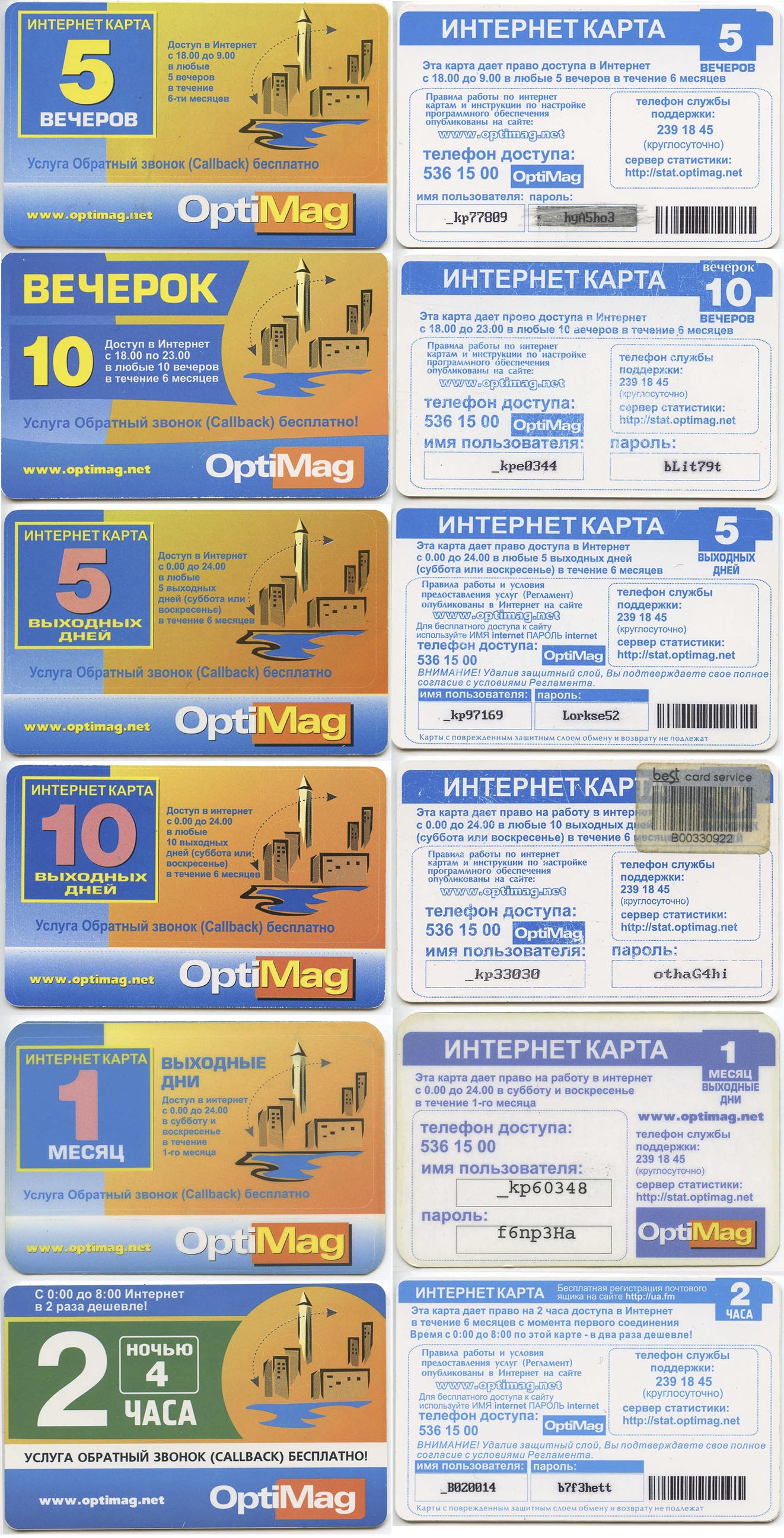
Around 2004, the Odessa provider TeNet starts offering unlimited access not only on weekends, but also on weekdays, both in Kiev and Odessa:

It's funny to read reviews of that time :

Yes, the speed of 5 KB / s was considered good! Well, “we want to eat a lot” we are now, when we say “badly”, which “pumps” 2 Mbit / s and the video slows down ...
It is because of this situation and unstable communication channels that download managers have gained popularity, which allowed downloading files when the connection was broken, continue or schedule downloads at a convenient time, and even speed up the download by simultaneously downloading the file into several “streams”. Perhaps the most popular of them at that time was Download Master, which was created by the Ukrainian company West Byte in 2002 and was completely free for the countries of the former Soviet Union, and in the foreign segment it is known as Internet Download Accelerator (IDA) and was a paid program (shareware license), which is logical, our people would never pay for software and would find a way to “hack” and save.
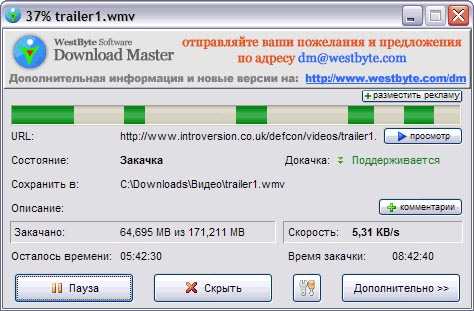
Yes, yes, the speed is exactly 5 Kbytes / s, which corresponds to a modem connection. By the way, due to data compression, TIFF files were pumped out at a speed of 2 Mbps, even using a modem connection, which theoretically could not provide speeds higher than 56 Kbps (7 Kilobytes / s), but I personally observed this speed when downloading using Download Master.
Later Download Master was indispensable even when connected via a dedicated line:
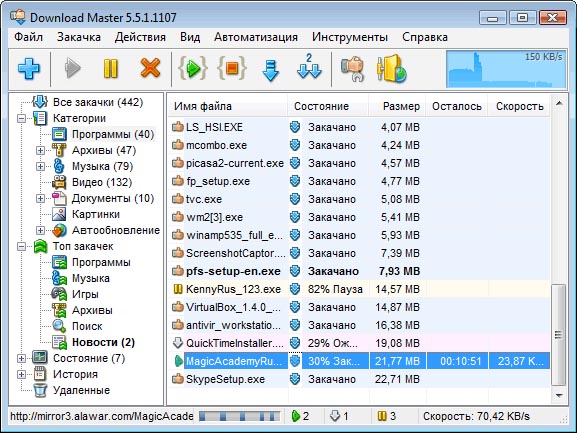
The speeds were still not very high, but I wanted to watch movies.
But back to the "Ukrtelecom". In the beginning of 2000, having created a 2 Mbit / s backbone network across the country, Ukrtelecom began to provide connectivity over a “dedicated line” at 64 Kbps and more using two or four wire connections, providing n * 64 digital channels Kbps ( ISDN ) or virtual frame relay channels. In 2001, the capacity of external (foreign) channels of Ukrtelecom becomes equal to 82 Mbit / s, compared to 8 Mbit / s, which accounted for all other Internet operators, making Ukrtelecom the absolute monopolist in the communications market for providing foreign channels. Since August 2002, Ukrtelecom has reduced prices 5 times for subscribers in Kiev and 8 times for regions, the cost of access using xDSL technology (leased line) becomes “very affordable” for subscribers :
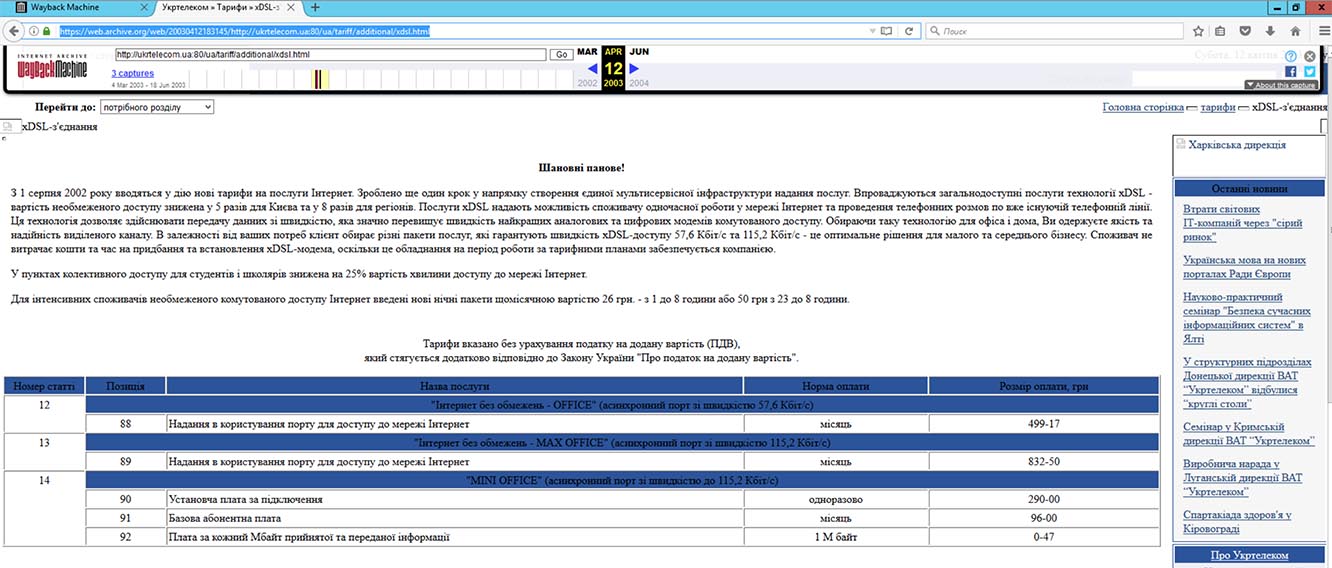
And it amounts to “only” 499.17 UAH / month (about $ 100 / month) for speeds up to 56.7 Kbps without traffic and 832.50 UAH / month ($ 166.5 / month) for access at speed 115, 2 Kbps A more “cheaper” option was offered, with a subscription fee of $ 20 and payment for traffic at a speed of 115.2 Kbps at a price of about $ 0.10 / MB (47 kopecks). It is easy to calculate that for $ 100 it was possible to pump only 1 GB of traffic using this tariff, which completely deprived this type of rating for the majority of subscribers. After all, with a speed of 115.2 Kbps, without taking into account, it was possible to download this month if you put the same download manager, about 115.2 / 8 * 86.4 * 30 = 37,324.8 MB of traffic, valued at $ 3,500 at this rate .
Thus, paying for access to the Internet at a speed of 115.2 Kbps with traffic and megabyte pricing was beneficial only in cases of infrequent use of the Internet, 1-2% of the total time (and downloading such a channel was 100% easy), which was comparable to 8 hours of “surfing” per month at maximum speed. In principle, it is possible and beneficial if you only look at websites and download almost nothing. Since in the case of Dial-Up and time rating, you had to disconnect from the modem pool every time, as soon as all the pages are downloaded and reconnected, if you need to follow the link somewhere, it took a lot of time and was accompanied by similar sounds:
And twice, if you are connected using the “Call Back” service. By the way, the connection “stretched” 7 times sounds interesting:
If you planned not only to surf, but also download data, it was advisable to use “unlimited” time plans, such as access over the weekend from OptiMag and you could download information for 48 hours, and parallel to “surf” in Internet and schedule subsequent downloads. Thus, over the weekend, it was quite realistic to download about 600-700 MB of data and pay $ 2 for it, which was certainly more profitable than access via dedicated lines, where the same amount of traffic could cost 50 or more times more. More precisely, it was more accessible, because not everyone could afford to pay $ 160 / month for Internet access, and not everyone needed 30 GB of traffic and loaded the 115.2K channel at 100% for a month, and Ukrtelecom actually counted on it offering such a tariff without regard to.
In 2002, Ukrtelecom connects regional centers at a speed of 155 Mbit / s, and regional from 2 to 8 Mbit / s, it is planned to increase the number of dial-up subscribers (Dial-Up) to 100,000, in which about $ 15 million was invested It was a real plan, as Ukrtelecom was a monopolist in Ukraine and almost the only provider in the regions. Very rarely, what provider could afford to build its own highway, without having sufficient investments, and Ukrtelecom used it. Selling Internet providers at extremely inflated prices. For example, a 4 Mbps channel without traffic was worth it! UAH 68309 per month ($ 13,661 / month) (for comparison, in Europe such a channel could cost about $ 600 / month), which was incredibly expensive even for Internet providers. Therefore, providers are starting to develop their core networks and external communication channels, although Ukrtelecom strongly discourages this. Later, of course, when the market became saturated, the operator lowered prices, thereby ensuring control over the Internet and wholesale customers, because selling a wide band became much more profitable than dragging the “last mile” to home subscribers. Yes, and providers make a choice in the direction of the channels of Ukrtelecom, as the alternative - satellite Internet, was more expensive and unstable. The increase in the subscriber base allowed providers to start building their own backbone channels over time and Ukrtelecom gradually, especially in large cities, began to lose its monopoly.
It is worth noting that the “inadequate” tariffs of Ukrtelecom with a subscription fee of over $ 20,000 / month for 8 Mbit / s without taking into account, could be found on the Ukrtelecom website even in 2005:

Nobody, of course, at such prices, being in his right mind, did not buy access.
In 2003-2004, an active development of the broadband Internet access market in Kiev took place. TV operator Volia is entering the market, offering Internet access using Docsis 1.0 technology via cable networks at speeds from 64 to 256 Kbps with traffic restrictions:
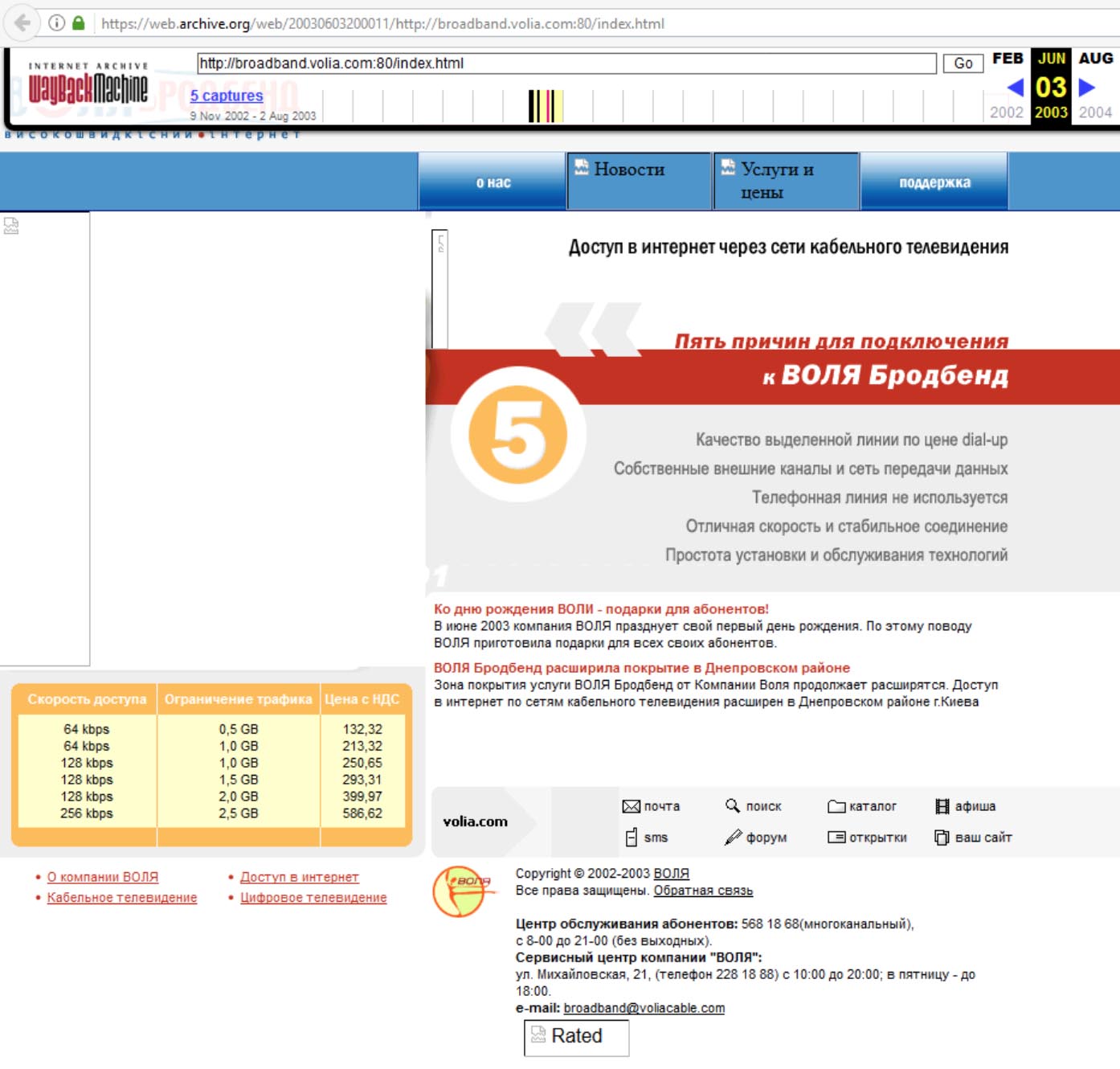
Prices from $ 26 / month for a package with an access speed of 64 Kbps and 500 MB of traffic per month (equivalent to 120 hours of dial-up access, at best, at 100% of the channel) to $ 117 for access at 256 Kbps and 2500 MB traffic per month. That is much better than the offer of "Ukrtelecom" in cases when the channel is not required to load 24/7. However, such access was still very expensive. Therefore, home networks are starting to gain popularity, offering traffic at a lower rate and at a higher speed, due to a batch purchase, for example, at $ 0.11 per MB, without a monthly fee, and at speeds up to 2 Mbps :
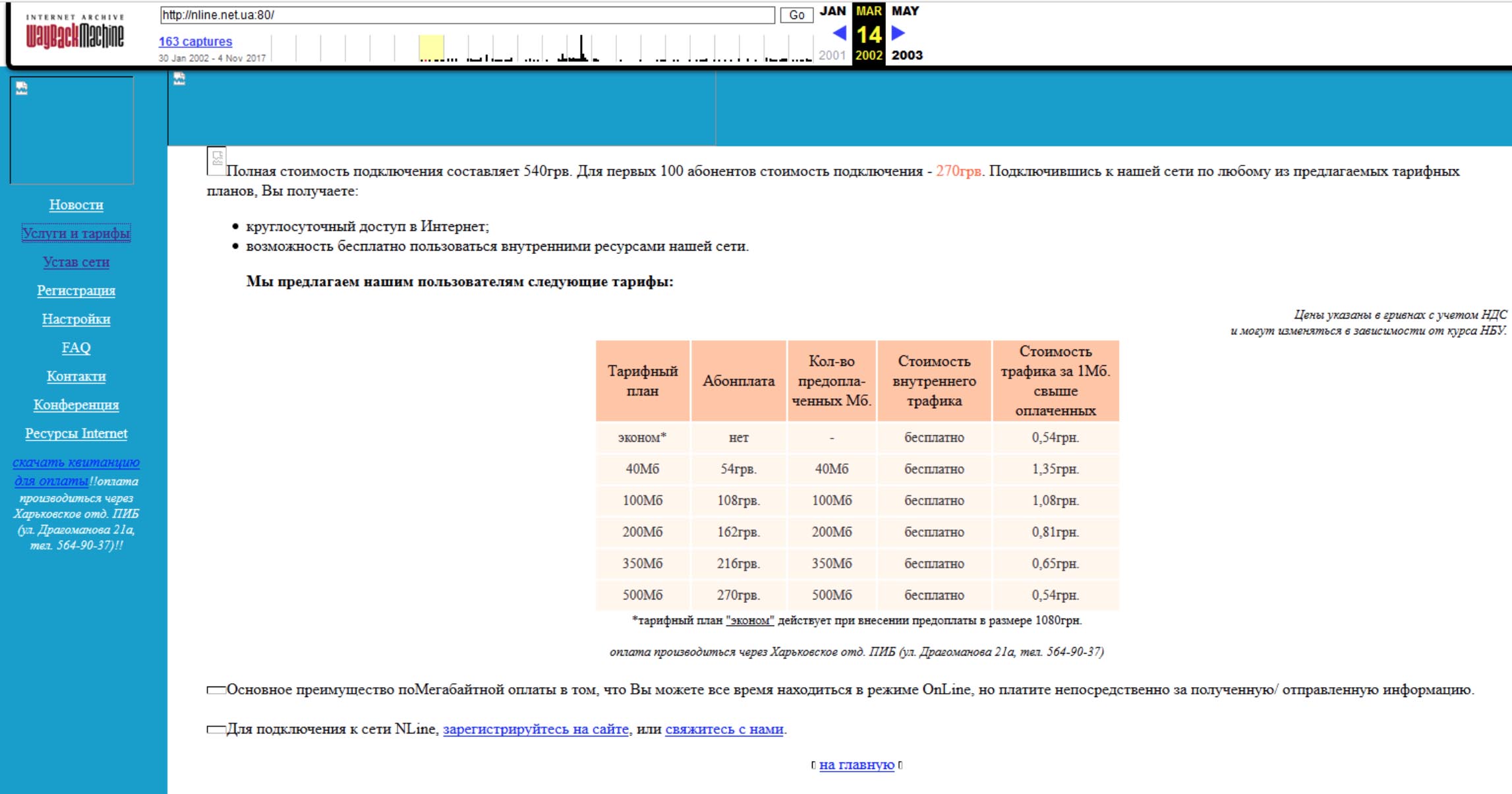
Which of course was very beneficial in the case of web browsing and for possible file sharing between “neighbors”, because the local traffic was free and the speed could reach 10 and even 100 Mbps for the local network, but I never connected to them from - due to the high connection fee (about $ 100) and the need to add another $ 200 to the balance. Later, over a short period of time, they also had a strange “Slow” tariff with 1000 MB of traffic and access speed, like a modem, at 6 Kb / s, while the cost was $ 50 monthly, but by the next update of the tariff plans they removed it and reduced the price of traffic to $ 0.055 / MB. Over time, the number of such home networks has grown, as has the number of sites located on servers in Kiev, and there is a need to provide cheaper and high-speed access to this information.
In order to be able to save on traffic and exchange traffic between subscribers from different networks of Kiev without using expensive foreign channels, in 2000 UA-IX (Ukrainian traffic exchange point) was created , the cost of connection to which at a speed of 100 Mbps was $ 1000, and the monthly fee was $ 50, the port 1000 Mbit / s cost $ 3000 one-time and $ 250 monthly, which allowed significant savings. However, there was a difficulty for the new participating providers - it was necessary to get approval from all the current participants and then drag their fiber-optic communication lines to Leontovich 9 (the center of Kiev), where the exchange point was physically located. At that time, the cost of laying 1 km of the fiber-optic line was about $ 1000 + it was necessary to pay money for renting the sewage to Ukrtelecom - about $ 10 / km monthly. It is easy to calculate that home networks from the Darnitskiy district of the capital should have invested about $ 15,000 in laying their own connection to the center and then paying another $ 250 + 150 monthly for the port at UA-IX at 1000 Mbps and renting the sewage system of Ukrtelecom to which fiber. Regional providers had to pay even more. Therefore, not every provider from the region could afford to be included in the exchange point directly, and therefore the IP transit service to UA-IX was sometimes in demand. In order to encourage connection to the exchange point of participants from other cities and even countries, it was decided to exempt them from the monthly fee, nevertheless, this relaxation did not cause a significant influx of those who wanted it - what is a discount of $ 50 or $ 250 monthly, if necessary, investment in laying hundreds of kilometers of fiber and rental of pillars and / or sewage through which cable runs? 2001 : 100 / UA-IX ($1200 , $110), 1000 / ($3850 , $550). , , .
2003 UA-IX — 100 / ($1210 , $110 ), 100 / ($220 , $110 ), 1000 / ($2530 , $330 ), 100 / ($33 , $33 ).
, FreeNet Fasty UA-IX 100 / :
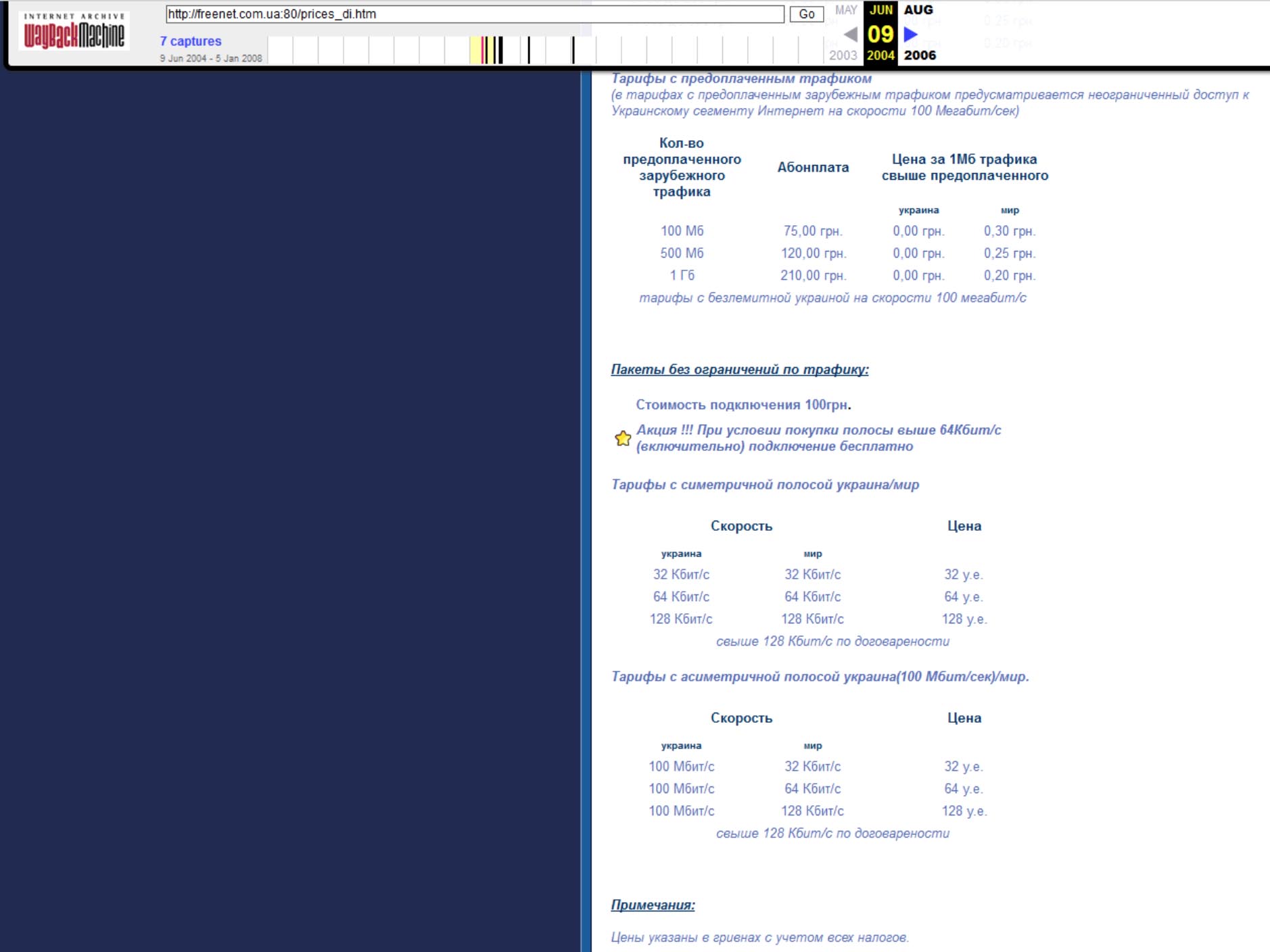
, FreeNet 128 / $128 / , «».
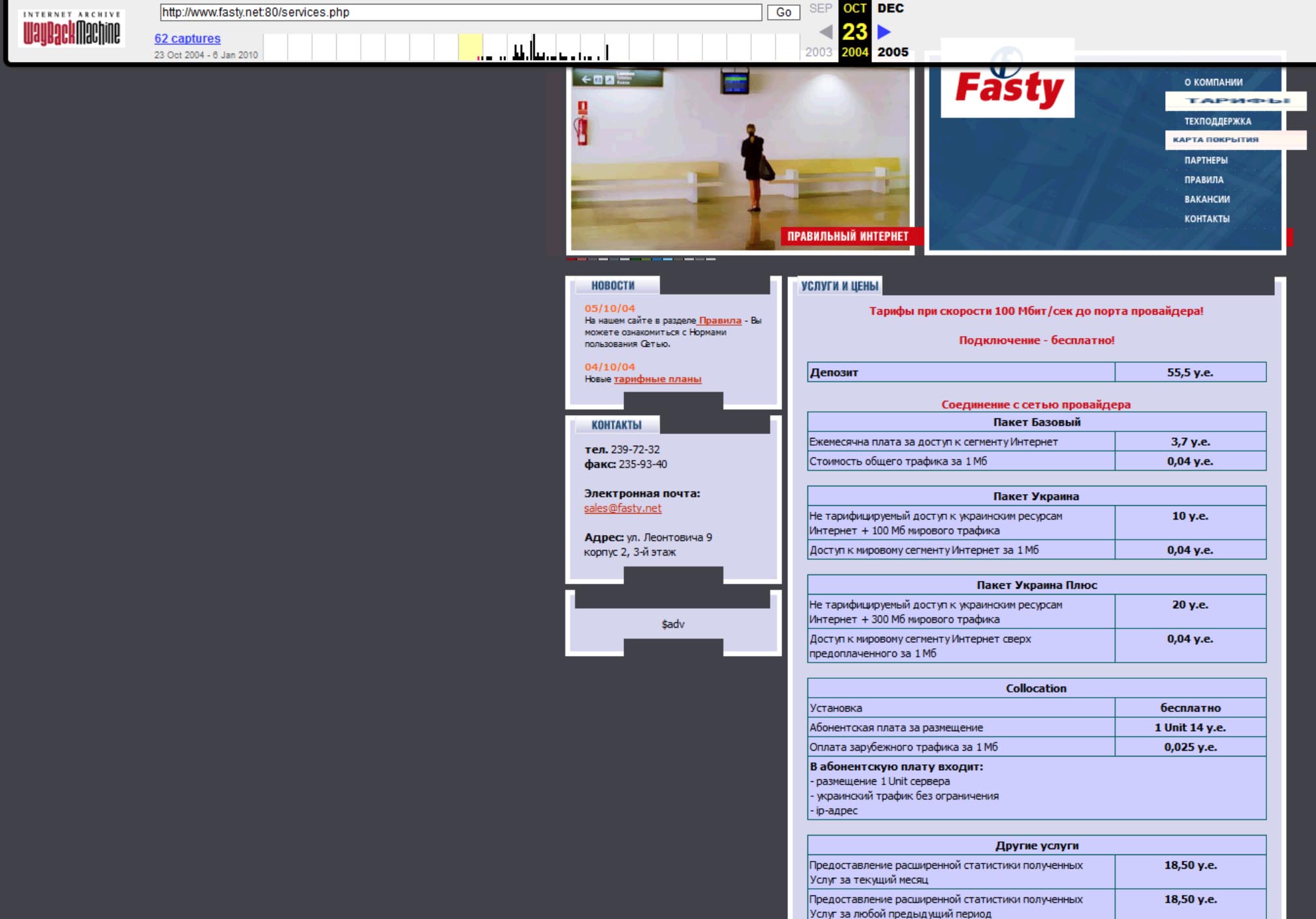
, , . , , . , . , Fasty, Nline, 2 ($0,055 ) «» , . , , «» , 12 ! Fasty , , :) 100 15 / , 7 .
«» :
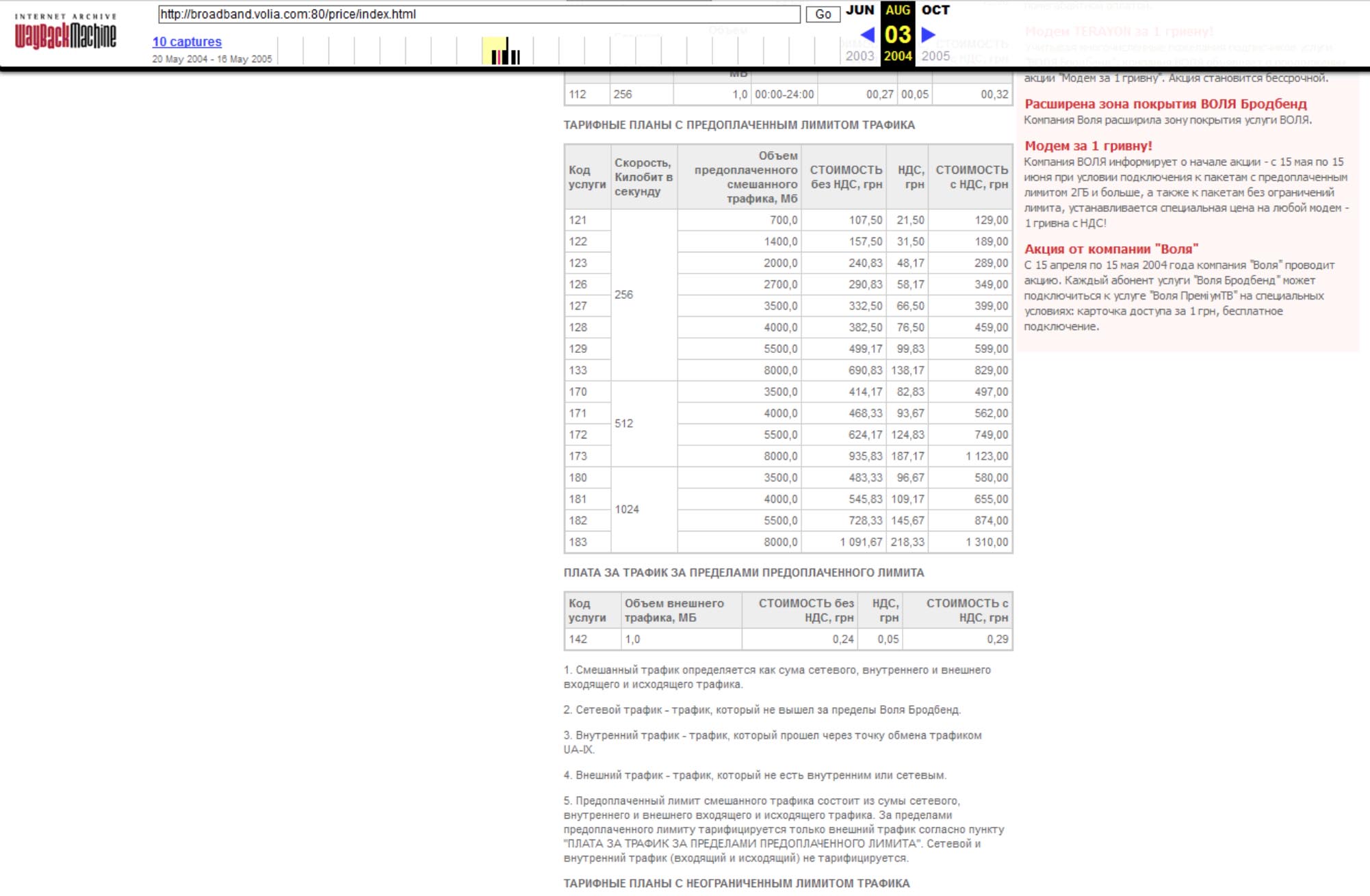
«» . 256 $270 / , 512 $520 / , 1 — $1020 / . 2 , Docsis 2.0 2 / , 100 ($20) 2 / 500 ( , , , ). , — . , 500 , , UA-IX 2 / $0,06. , «» . , , — FreeNet, 100 / .
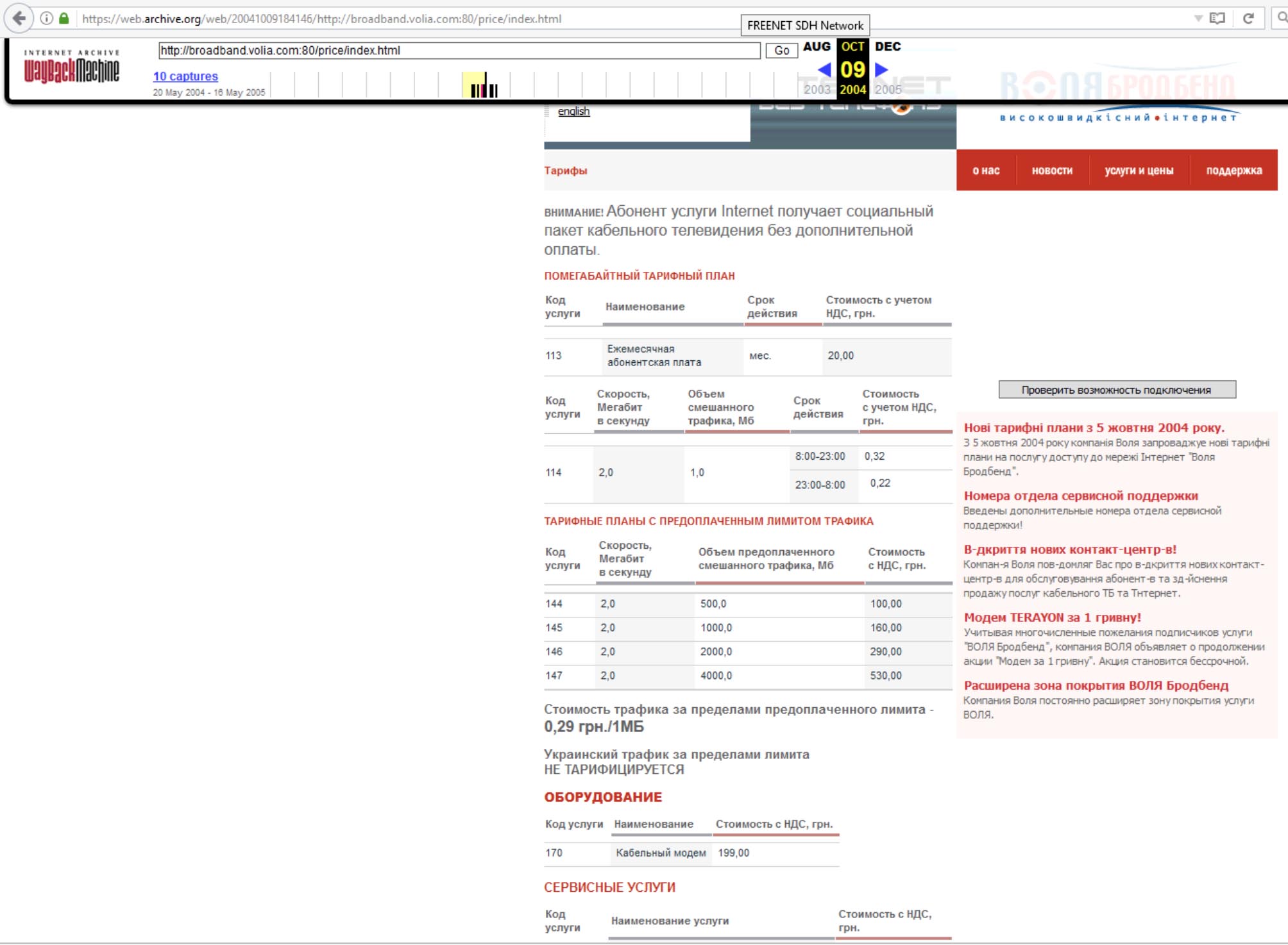
, torrent . CMST 38 / . «» 2005 , (5000 ), «» - , «» . - , . , , — 256 / , «». 2 / «» , , .
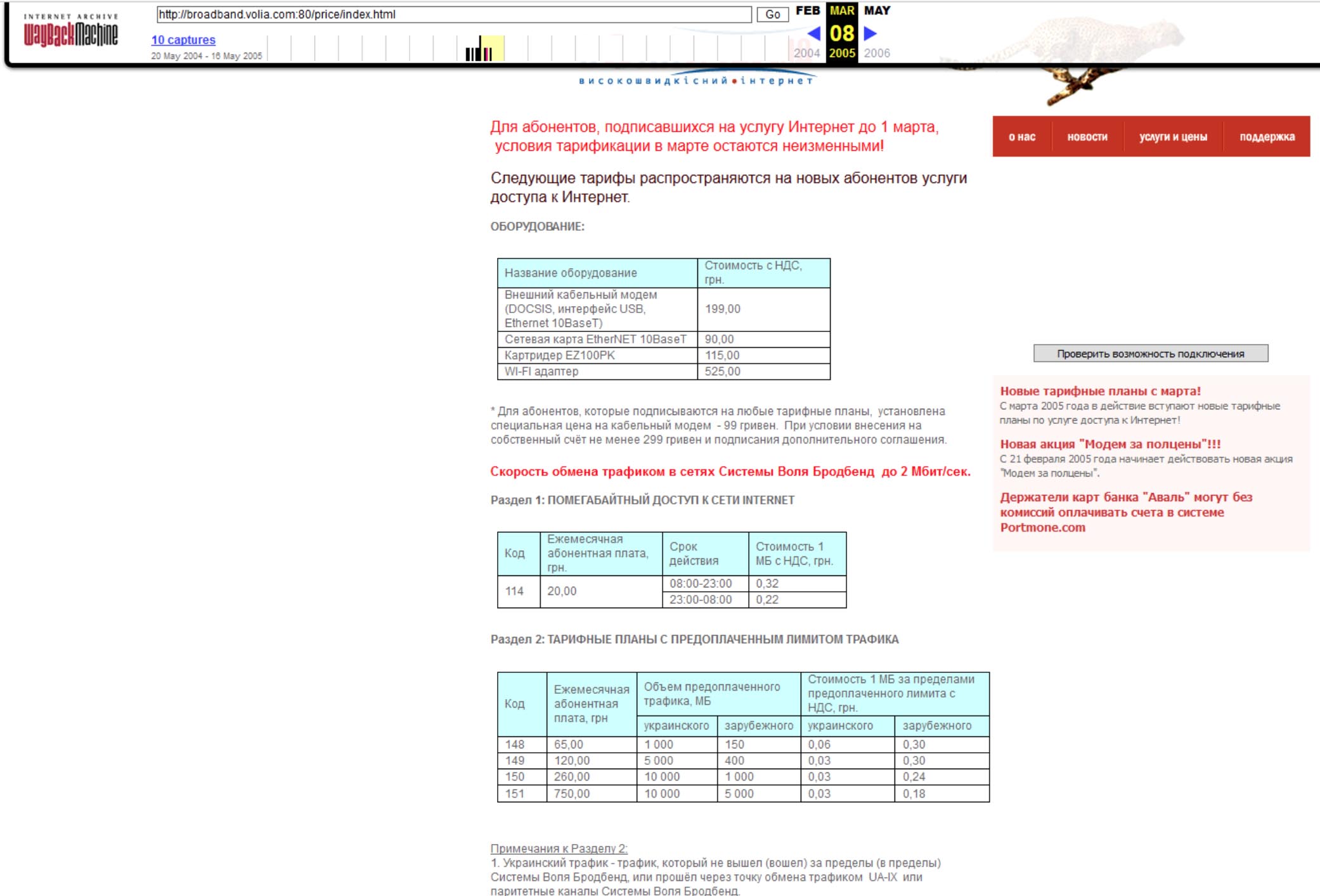
«» «» xDSL 115 / $22 / , $0,04 / . «» — UA-IX, . «» 2, 10, 100 / . , «», .
, «» xDSL 58 / ($11,6), , ADSL, «» , ADSL (2,5 $80 512 128 ). «» ( 2005):
128 / ()
64 / () 1554-58 ($310,92)
256 / ()
64 / () 2798-00 ($559,60)
512 / ()
128 / () 5000-00 ($1000)
, UA-IX, . VPN. NetAssist, 2003 - :
:
, VPN NetAssist $30 GB 2003 , 2005 GoodNight $8,7 , $25 / , 4 .

VPN IP-, IP, $5 / . , , , NetAssist « » , , «», . IPNet, VPN-, « », , torrent-, , . NLine .
2006 «» GPRS (a Dial-Up ). WAP $2 30 , , 500 / ($100).
WAP-c :
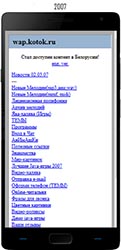
:)
C GPRS- , - — $1 / . 2007 384 / «» EDGE. , 2004 — , , , . , 2008 «» 1000 — 200 ($25), 2007 80% EDGE-.
2006 CDMA «PeopleNet» , CDMA 3G, - , 3G :

C 10 ($0,02), 3,6 / ( ), — . , . , — . «», 2004 , , «PeopleNet». «» WAP. 2006 :
, «PeopleNet» , «» 3G CDMA2000 1x EV-DO rel.0 Lucent Technologies, 2007 300-500 / ( 2 / ) $0,03 / . 2008 CDMA2000 1x EV-DO rev.A, «» , , 2011 «» «PeopleNet» CDMA2000 1x EV-DO rev.B, 14,7 / , , .
, , 2009 , 25 $35:
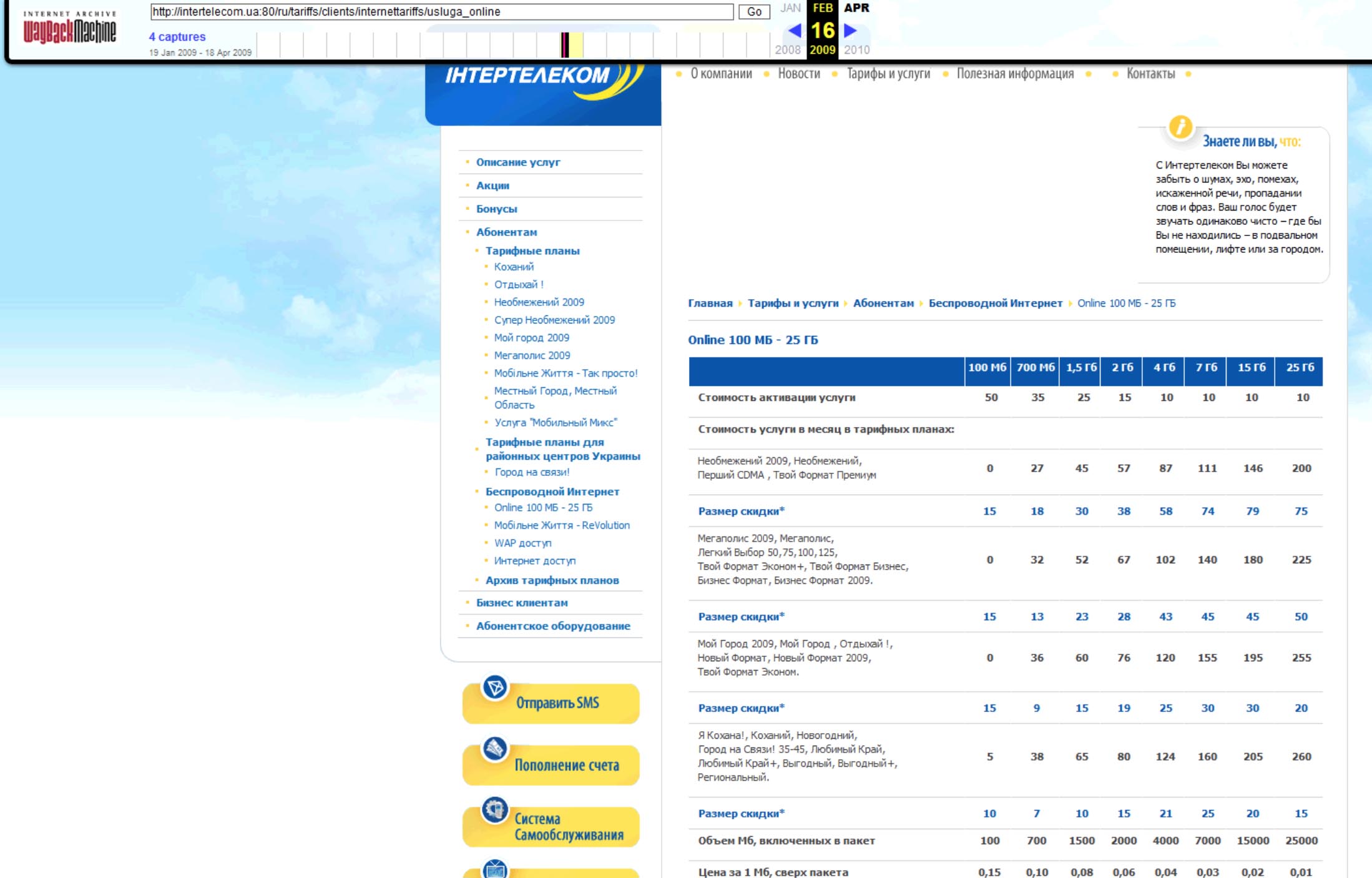
2009 «» , , LTE , , WIMAX. «Freshtel» 20 / 10 ($1,25) 180 / ($22,5).
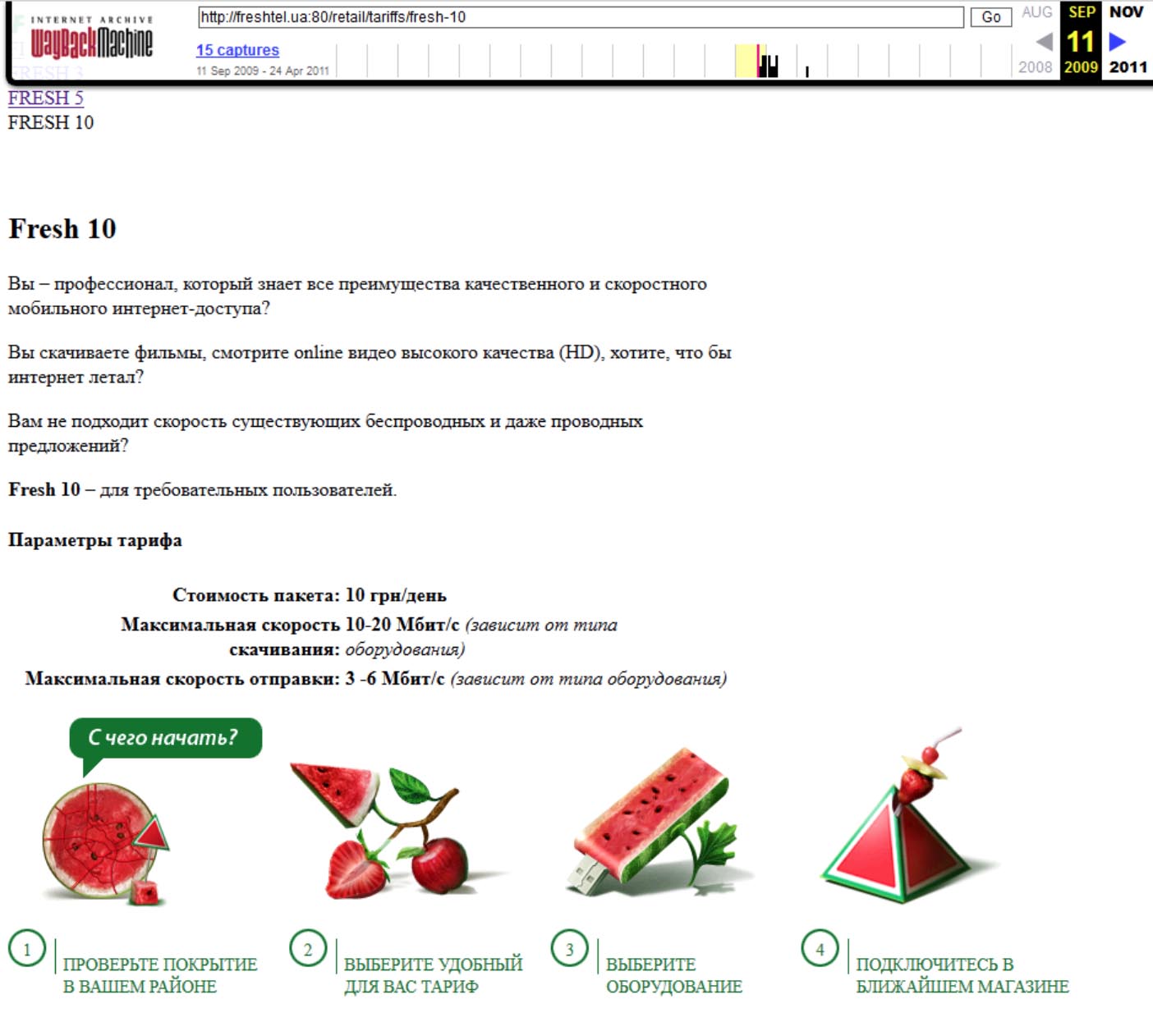
, , , WIMAX . 2011 , , . 2015, - 3G:
«Freshtel» - , 3G ( 16 / , 7 / ) , — . , , . , , «FreshTel» , , .
Astelit 3G :

, , . , , LTE. - .
2005. «» ADSL 2 / . . 4 286 ($57), 2006 «» , 2014 , «»:
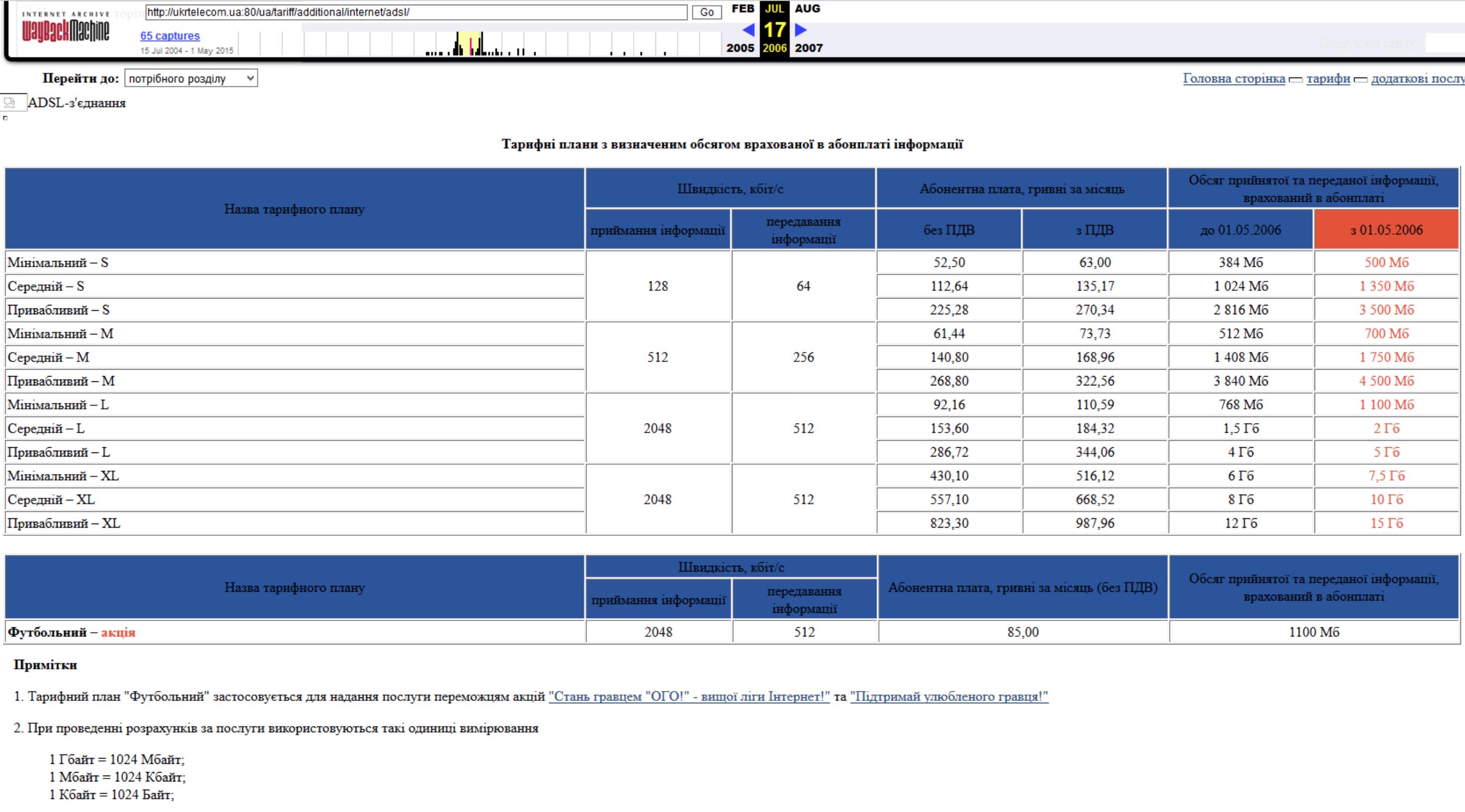
— $360 512 2007 - , $30 512/128 , .
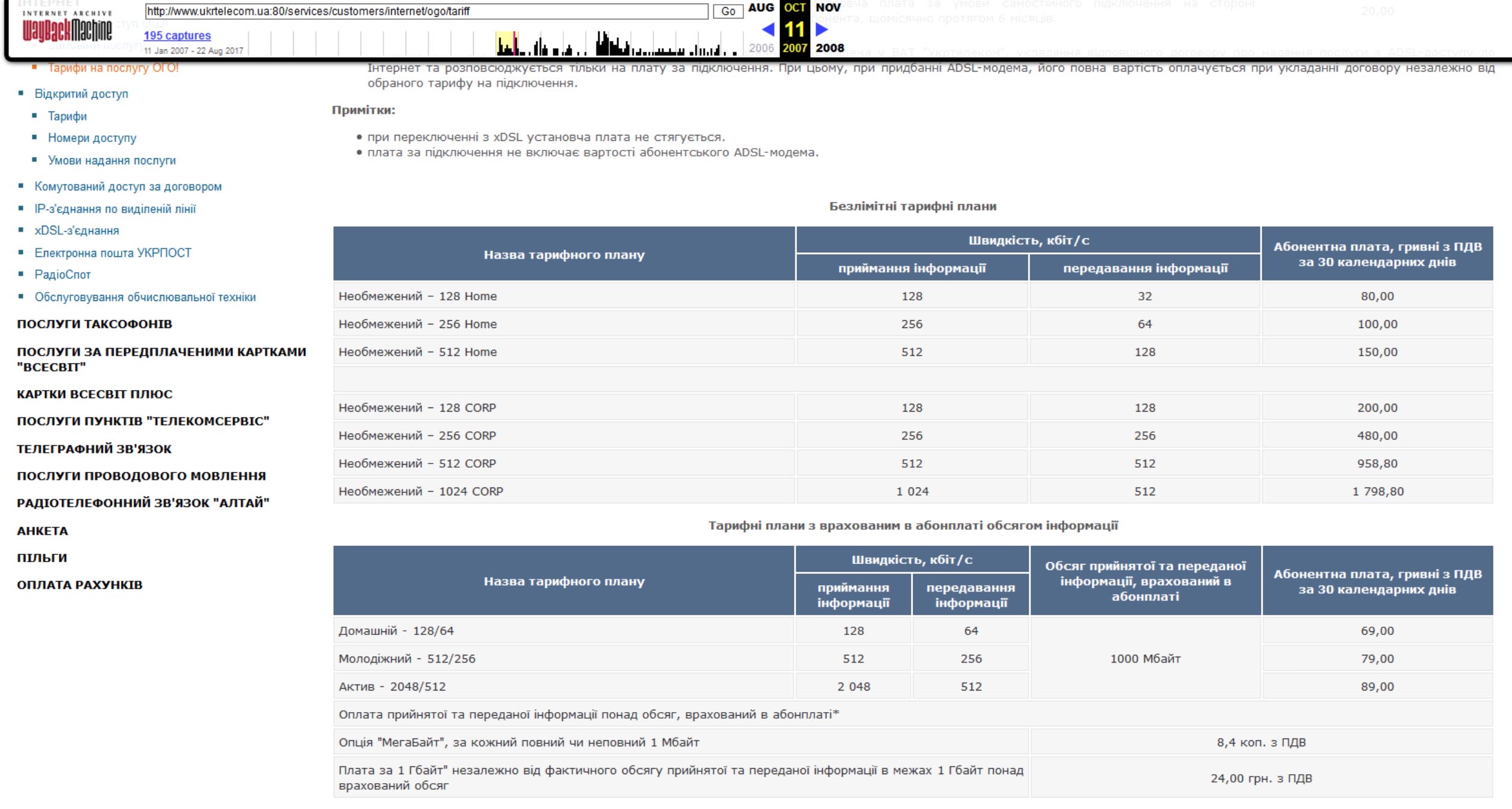
8 / . , 14 DSL, VDSL, 300 / :

, DSL , , , « ». «» — , . , , IT- -, web, « . : $0 $200 100 / ?» .
BLACK FRIDAY : 30% - BLACK30% 1-6 !
These are not just virtual servers! This is a VPS (KVM) with dedicated drives, which can be no worse than dedicated servers, and in most cases - better! We made VPS (KVM) with dedicated drives in the Netherlands and the USA (configurations from VPS (KVM) - E5-2650v4 (6 Cores) / 10GB DDR4 / 240GB SSD or 4TB HDD / 1Gbps 10TB available at a uniquely low price - from $ 29 / month , options are available with RAID1 and RAID10) , do not miss the chance to place an order for a new type of virtual server, where all resources belong to you, as on a dedicated one, and the price is much lower, with a much more productive hardware!
How to build the infrastructure of the building. class c using servers Dell R730xd E5-2650 v4 worth 9000 euros for a penny? Dell R730xd 2 times cheaper? Only we have 2 x Intel Dodeca-Core Xeon E5-2650v4 128GB DDR4 6x480GB SSD 1Gbps 100 TV from $ 249 in the Netherlands and the USA!

Moreover, this year marks 20 years since Ukrtelecom received the first foreign channel of huge capacity at that time in Ukraine - 2 Mbit / s to London. Yes, yes, 2 Mbit / s in 1997 to the whole country! And how do you remember the Internet? In the comments to this publication I propose to share your experience, when you first came online and how it was. It is necessary for the formation of a general picture of how much the transfer of data has decreased and what unique opportunities we have with you today in comparison with the era of the emergence of Internet providers. Let's start!
Back in 1988, the first experiments with data transmission on the territory of modern Ukraine were started by Ukrainian scientists, but the first providers appeared only in 1990. At that time, the electronic messaging service was widely spread in the world, and in the USSR one of the leading operators providing this service was "Relcom". In Ukraine, regional centers of access to this network were established at telephone and telegraph stations. Very soon, these sites came under the management of the newly established company “Relcom-Ukraine”, and therefore the Internet of that time was called by many “Relcom”.
Since 1991, a new joint venture, Infocom, was formed, which began building a national scale network based on long-distance analog channels of the Ministry of Communications of Ukraine, and the network has access to international data networks. A little later, thanks to the initiative of enthusiasts, the Internet zone .UA was obtained in 1992, and the Kharkov company Konkom, providing dial-up access between Kharkov and Moscow, acquired a dedicated line in this direction and was the first in Ukraine to switch to the Internet protocol TCP-IP , thus first implementing uninterrupted online access to the Internet network.
In 1994, there were already a few dozen Internet service providers in Ukraine, but the scale of Internet penetration was insignificant until 1999, when the number of subscribers in Kiev reached 10,000, access to the network for which was provided by about 50 providers. All this did not allow them in Ukraine to significantly modernize and expand their networks. However, nevertheless, in the initial period, this activity was not regulated by the state in any way, which allowed for healthy competition, in the absence of expensive licensing, which, however, they tried to introduce repeatedly, but most of the providers continued to operate without a license and the attempts of the authorities were unsuccessful.
At the end of 1994, Infocom invests about $ 3 million to build a national scale network, unites Kiev, Dnepropetrovsk, Lviv and Odessa, while providing Internet access for only 1000+ clients. A little later, Golden Telecom and Farlep are also actively building their own backbone networks between the major cities of Ukraine, which has a significant impact on the cost of their services, which only large companies could afford.
Home users appear the first local area networks in 1994-1996, mainly for the purpose of gaming and file sharing, initially uniting several computers within an apartment building that do not have access to the Internet. After a decade, the most active of them will turn into major Internet service providers providing access for hundreds, thousands and tens of thousands of subscribers at space speeds for the 90s - tens of megabits per second.
It is worth noting that www originates in 1991, along with html and http, however, the first Mosaic browser appeared only in 1993, and www gained popularity perhaps only from 1996, before that the Internet was used mainly for file transfer and e-mail.
The first international fiber-optic communication line (FOCL) was built in 1996 as part of the international project ITUR, it passed through Palermo (Italy), Istanbul (Turkey), Odessa (Ukraine) and ended in Novosibirsk (Russia). The total length of the VOLS was 3500 km, and the cost of the project exceeded $ 150 million. At the same time, the Kiev-Odessa FOCL was 975 km long with branches to Kirovograd, Nikolaev and Cherkasy.
Since 1997, Ukrtelecom has entered the market, opening the first Internet site in Kiev, connected to the UUNET site in London at a speed of 2 Mbit / s via a fiber-optic communication line. Until the beginning of 2000, several more nodes appeared in large cities, but the Ukrtelecom network began to develop massively only in 2000, when the nodes were created in all major regional and district centers and received a connection between them at a speed of 2 Mbit / s.
At the end of 2000, Ukrtelecom began providing Internet access services via Dial-up for home users, and in the summer of 2001, in order to crush competitors, it introduces the pricing of city telephony immediately after the transition from analog telephone to digital lines is completed, which made the service of competitors automatically more expensive . The very same “Ukrtelecom”, after a while, offers Internet access “for free”, in exchange for the city telephone service, about 3.6 UAH / hour ($ 0.72 / hour), thereby changing the rules of the game in the market of dial-up connection .
Gradually, the “callback” service began to gain popularity when, after the connection was established, the modem pool, using the AT command, sent, disconnected the Internet connection and called back the modem that was in standby mode for the connection from the ISP.
I still have several access cards from that period. Who comes from Kiev - has the opportunity to ponozhalgirovat :)
Providers such as “Sweet Online” (Dial-Up brand “Golden Telecom”):

We have lost a huge number of subscribers since the introduction of per-minute billing of local telephone communications, including me, because they did not provide the “Call Back” service.
The Call Back service itself became very popular and probably remained in operation until 2011, despite the proliferation of leased lines and broadband Internet access, here are a few cards from that period from Internet providers providing access in Kiev:

A little later, closer to 2003, Optima-Telecom , a Dnepropetrovsk provider , is entering the market, which is starting to provide freer access to the Internet by offering package rates.
So a 10-party card (Internet access from 18 to 23) cost 28 hryvnias ($ 5.6), not to be confused with a 10-night card (Internet access from 18 to 9 am), and a card with unlimited Internet access only Weekends during the month - cost around 48 hryvnia ($ 9.6), for the rest of the time access was offered by the hour, and at night access was twice as cheap as day:

Around 2004, the Odessa provider TeNet starts offering unlimited access not only on weekends, but also on weekdays, both in Kiev and Odessa:

It's funny to read reviews of that time :

Yes, the speed of 5 KB / s was considered good! Well, “we want to eat a lot” we are now, when we say “badly”, which “pumps” 2 Mbit / s and the video slows down ...
It is because of this situation and unstable communication channels that download managers have gained popularity, which allowed downloading files when the connection was broken, continue or schedule downloads at a convenient time, and even speed up the download by simultaneously downloading the file into several “streams”. Perhaps the most popular of them at that time was Download Master, which was created by the Ukrainian company West Byte in 2002 and was completely free for the countries of the former Soviet Union, and in the foreign segment it is known as Internet Download Accelerator (IDA) and was a paid program (shareware license), which is logical, our people would never pay for software and would find a way to “hack” and save.

Yes, yes, the speed is exactly 5 Kbytes / s, which corresponds to a modem connection. By the way, due to data compression, TIFF files were pumped out at a speed of 2 Mbps, even using a modem connection, which theoretically could not provide speeds higher than 56 Kbps (7 Kilobytes / s), but I personally observed this speed when downloading using Download Master.
Later Download Master was indispensable even when connected via a dedicated line:

The speeds were still not very high, but I wanted to watch movies.
But back to the "Ukrtelecom". In the beginning of 2000, having created a 2 Mbit / s backbone network across the country, Ukrtelecom began to provide connectivity over a “dedicated line” at 64 Kbps and more using two or four wire connections, providing n * 64 digital channels Kbps ( ISDN ) or virtual frame relay channels. In 2001, the capacity of external (foreign) channels of Ukrtelecom becomes equal to 82 Mbit / s, compared to 8 Mbit / s, which accounted for all other Internet operators, making Ukrtelecom the absolute monopolist in the communications market for providing foreign channels. Since August 2002, Ukrtelecom has reduced prices 5 times for subscribers in Kiev and 8 times for regions, the cost of access using xDSL technology (leased line) becomes “very affordable” for subscribers :

And it amounts to “only” 499.17 UAH / month (about $ 100 / month) for speeds up to 56.7 Kbps without traffic and 832.50 UAH / month ($ 166.5 / month) for access at speed 115, 2 Kbps A more “cheaper” option was offered, with a subscription fee of $ 20 and payment for traffic at a speed of 115.2 Kbps at a price of about $ 0.10 / MB (47 kopecks). It is easy to calculate that for $ 100 it was possible to pump only 1 GB of traffic using this tariff, which completely deprived this type of rating for the majority of subscribers. After all, with a speed of 115.2 Kbps, without taking into account, it was possible to download this month if you put the same download manager, about 115.2 / 8 * 86.4 * 30 = 37,324.8 MB of traffic, valued at $ 3,500 at this rate .
Thus, paying for access to the Internet at a speed of 115.2 Kbps with traffic and megabyte pricing was beneficial only in cases of infrequent use of the Internet, 1-2% of the total time (and downloading such a channel was 100% easy), which was comparable to 8 hours of “surfing” per month at maximum speed. In principle, it is possible and beneficial if you only look at websites and download almost nothing. Since in the case of Dial-Up and time rating, you had to disconnect from the modem pool every time, as soon as all the pages are downloaded and reconnected, if you need to follow the link somewhere, it took a lot of time and was accompanied by similar sounds:
And twice, if you are connected using the “Call Back” service. By the way, the connection “stretched” 7 times sounds interesting:
If you planned not only to surf, but also download data, it was advisable to use “unlimited” time plans, such as access over the weekend from OptiMag and you could download information for 48 hours, and parallel to “surf” in Internet and schedule subsequent downloads. Thus, over the weekend, it was quite realistic to download about 600-700 MB of data and pay $ 2 for it, which was certainly more profitable than access via dedicated lines, where the same amount of traffic could cost 50 or more times more. More precisely, it was more accessible, because not everyone could afford to pay $ 160 / month for Internet access, and not everyone needed 30 GB of traffic and loaded the 115.2K channel at 100% for a month, and Ukrtelecom actually counted on it offering such a tariff without regard to.
In 2002, Ukrtelecom connects regional centers at a speed of 155 Mbit / s, and regional from 2 to 8 Mbit / s, it is planned to increase the number of dial-up subscribers (Dial-Up) to 100,000, in which about $ 15 million was invested It was a real plan, as Ukrtelecom was a monopolist in Ukraine and almost the only provider in the regions. Very rarely, what provider could afford to build its own highway, without having sufficient investments, and Ukrtelecom used it. Selling Internet providers at extremely inflated prices. For example, a 4 Mbps channel without traffic was worth it! UAH 68309 per month ($ 13,661 / month) (for comparison, in Europe such a channel could cost about $ 600 / month), which was incredibly expensive even for Internet providers. Therefore, providers are starting to develop their core networks and external communication channels, although Ukrtelecom strongly discourages this. Later, of course, when the market became saturated, the operator lowered prices, thereby ensuring control over the Internet and wholesale customers, because selling a wide band became much more profitable than dragging the “last mile” to home subscribers. Yes, and providers make a choice in the direction of the channels of Ukrtelecom, as the alternative - satellite Internet, was more expensive and unstable. The increase in the subscriber base allowed providers to start building their own backbone channels over time and Ukrtelecom gradually, especially in large cities, began to lose its monopoly.
It is worth noting that the “inadequate” tariffs of Ukrtelecom with a subscription fee of over $ 20,000 / month for 8 Mbit / s without taking into account, could be found on the Ukrtelecom website even in 2005:

Nobody, of course, at such prices, being in his right mind, did not buy access.
In 2003-2004, an active development of the broadband Internet access market in Kiev took place. TV operator Volia is entering the market, offering Internet access using Docsis 1.0 technology via cable networks at speeds from 64 to 256 Kbps with traffic restrictions:

Prices from $ 26 / month for a package with an access speed of 64 Kbps and 500 MB of traffic per month (equivalent to 120 hours of dial-up access, at best, at 100% of the channel) to $ 117 for access at 256 Kbps and 2500 MB traffic per month. That is much better than the offer of "Ukrtelecom" in cases when the channel is not required to load 24/7. However, such access was still very expensive. Therefore, home networks are starting to gain popularity, offering traffic at a lower rate and at a higher speed, due to a batch purchase, for example, at $ 0.11 per MB, without a monthly fee, and at speeds up to 2 Mbps :

Which of course was very beneficial in the case of web browsing and for possible file sharing between “neighbors”, because the local traffic was free and the speed could reach 10 and even 100 Mbps for the local network, but I never connected to them from - due to the high connection fee (about $ 100) and the need to add another $ 200 to the balance. Later, over a short period of time, they also had a strange “Slow” tariff with 1000 MB of traffic and access speed, like a modem, at 6 Kb / s, while the cost was $ 50 monthly, but by the next update of the tariff plans they removed it and reduced the price of traffic to $ 0.055 / MB. Over time, the number of such home networks has grown, as has the number of sites located on servers in Kiev, and there is a need to provide cheaper and high-speed access to this information.
In order to be able to save on traffic and exchange traffic between subscribers from different networks of Kiev without using expensive foreign channels, in 2000 UA-IX (Ukrainian traffic exchange point) was created , the cost of connection to which at a speed of 100 Mbps was $ 1000, and the monthly fee was $ 50, the port 1000 Mbit / s cost $ 3000 one-time and $ 250 monthly, which allowed significant savings. However, there was a difficulty for the new participating providers - it was necessary to get approval from all the current participants and then drag their fiber-optic communication lines to Leontovich 9 (the center of Kiev), where the exchange point was physically located. At that time, the cost of laying 1 km of the fiber-optic line was about $ 1000 + it was necessary to pay money for renting the sewage to Ukrtelecom - about $ 10 / km monthly. It is easy to calculate that home networks from the Darnitskiy district of the capital should have invested about $ 15,000 in laying their own connection to the center and then paying another $ 250 + 150 monthly for the port at UA-IX at 1000 Mbps and renting the sewage system of Ukrtelecom to which fiber. Regional providers had to pay even more. Therefore, not every provider from the region could afford to be included in the exchange point directly, and therefore the IP transit service to UA-IX was sometimes in demand. In order to encourage connection to the exchange point of participants from other cities and even countries, it was decided to exempt them from the monthly fee, nevertheless, this relaxation did not cause a significant influx of those who wanted it - what is a discount of $ 50 or $ 250 monthly, if necessary, investment in laying hundreds of kilometers of fiber and rental of pillars and / or sewage through which cable runs? 2001 : 100 / UA-IX ($1200 , $110), 1000 / ($3850 , $550). , , .
2003 UA-IX — 100 / ($1210 , $110 ), 100 / ($220 , $110 ), 1000 / ($2530 , $330 ), 100 / ($33 , $33 ).
, FreeNet Fasty UA-IX 100 / :

, FreeNet 128 / $128 / , «».

, , . , , . , . , Fasty, Nline, 2 ($0,055 ) «» , . , , «» , 12 ! Fasty , , :) 100 15 / , 7 .
«» :

«» . 256 $270 / , 512 $520 / , 1 — $1020 / . 2 , Docsis 2.0 2 / , 100 ($20) 2 / 500 ( , , , ). , — . , 500 , , UA-IX 2 / $0,06. , «» . , , — FreeNet, 100 / .

, torrent . CMST 38 / . «» 2005 , (5000 ), «» - , «» . - , . , , — 256 / , «». 2 / «» , , .

«» «» xDSL 115 / $22 / , $0,04 / . «» — UA-IX, . «» 2, 10, 100 / . , «», .
, «» xDSL 58 / ($11,6), , ADSL, «» , ADSL (2,5 $80 512 128 ). «» ( 2005):
128 / ()
64 / () 1554-58 ($310,92)
256 / ()
64 / () 2798-00 ($559,60)
512 / ()
128 / () 5000-00 ($1000)
, UA-IX, . VPN. NetAssist, 2003 - :
, … ! Like this? ! , , , , , — ! , «» .
:
, ? : (), .
? ( ), RIPE country: UA. , : www.merezha.net/ua , «» .
— , 64 2 ... 2.
, ... . ( ) — .
, VPN NetAssist $30 GB 2003 , 2005 GoodNight $8,7 , $25 / , 4 .

VPN IP-, IP, $5 / . , , , NetAssist « » , , «», . IPNet, VPN-, « », , torrent-, , . NLine .
?
2006 «» GPRS (a Dial-Up ). WAP $2 30 , , 500 / ($100).
WAP-c :

:)
C GPRS- , - — $1 / . 2007 384 / «» EDGE. , 2004 — , , , . , 2008 «» 1000 — 200 ($25), 2007 80% EDGE-.
2006 CDMA «PeopleNet» , CDMA 3G, - , 3G :

C 10 ($0,02), 3,6 / ( ), — . , . , — . «», 2004 , , «PeopleNet». «» WAP. 2006 :
«WAP-» — !
, WAP-, - WAP-. WAP- .
, — , WAP- «»: , , , , , , , .
, «PeopleNet» , «» 3G CDMA2000 1x EV-DO rel.0 Lucent Technologies, 2007 300-500 / ( 2 / ) $0,03 / . 2008 CDMA2000 1x EV-DO rev.A, «» , , 2011 «» «PeopleNet» CDMA2000 1x EV-DO rev.B, 14,7 / , , .
, , 2009 , 25 $35:

2009 «» , , LTE , , WIMAX. «Freshtel» 20 / 10 ($1,25) 180 / ($22,5).

, , , WIMAX . 2011 , , . 2015, - 3G:
«», life:), 3G 650 — 3,355 . , , , «» . «» 3G — 4 19 . 3G+ 147 17 , 60% 47% . , 40% 3G- , Youtube, Play Market, Cloud . life:) 7,5 Youtube .
«Freshtel» - , 3G ( 16 / , 7 / ) , — . , , . , , «FreshTel» , , .
Astelit 3G :

, , . , , LTE. - .
2005. «» ADSL 2 / . . 4 286 ($57), 2006 «» , 2014 , «»:

— $360 512 2007 - , $30 512/128 , .

8 / . , 14 DSL, VDSL, 300 / :

, DSL , , , « ». «» — , . , , IT- -, web, « . : $0 $200 100 / ?» .
BLACK FRIDAY : 30% - BLACK30% 1-6 !
These are not just virtual servers! This is a VPS (KVM) with dedicated drives, which can be no worse than dedicated servers, and in most cases - better! We made VPS (KVM) with dedicated drives in the Netherlands and the USA (configurations from VPS (KVM) - E5-2650v4 (6 Cores) / 10GB DDR4 / 240GB SSD or 4TB HDD / 1Gbps 10TB available at a uniquely low price - from $ 29 / month , options are available with RAID1 and RAID10) , do not miss the chance to place an order for a new type of virtual server, where all resources belong to you, as on a dedicated one, and the price is much lower, with a much more productive hardware!
How to build the infrastructure of the building. class c using servers Dell R730xd E5-2650 v4 worth 9000 euros for a penny? Dell R730xd 2 times cheaper? Only we have 2 x Intel Dodeca-Core Xeon E5-2650v4 128GB DDR4 6x480GB SSD 1Gbps 100 TV from $ 249 in the Netherlands and the USA!
All Articles